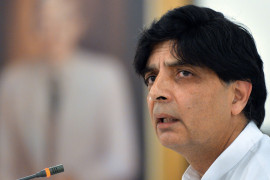
The discovery that ‘magnetic’ ink was not used in some constituencies in the May 2013 general elections has given rise to a controversy – and for good reason.
The special ink was prepared by Pakistan Council of Scientific and Industrial Research (PCSIR) on the request of the Election Commission of Pakistan (ECP). The ink, suggested for use by the National Database Registration Authority (Nadra), set back the ECP Rs86 million – costing some four times what regular ink would cost.
Why?
While the use of regular ink doesn’t mean that the prints cannot be identified – given that many official documents still use regular ink – it makes life a lot tougher.
The readability of a thumb impression does not necessarily depend on the use of magnetic ink but on the way the thumb impression has stamped, said one NADRA official.
That is where the usefulness of the special magnetic ink comes in: in the effort to circumvent dependency on chance. The ink contains iron particles which is attracted to lines (skin ridges in the thumb), which enhances readability of the lines – an impression is more difficult, though not impossible, to read once ink enters between the skin ridges because it produces a smudge instead of a pattern.
There are around 130-150 unique ridges in the thumb of every person. And if 15-20 unique characters/lines of a thumb are readable, it helps identification. It also means that when there is an investigation of a given polling booth or constituency, electronic reading of the impressions on ballot papers is a lot faster and more accurate.
What happened?
The non-use of this special ink during the May 2013 elections first came forward in two National Assembly constituencies in Karachi – and that set the cat among the pigeons.
The issue has now spiraled into a larger one – one that has involved a number of quarters going as far as to question the veracity of the entire electoral process.
It was the ECP’s initiative to use magnetic ink in the general elections and the poll body says it will hold an investigation.
“We are waiting for the election tribunals to complete their job and then will investigate the matter as to why, if magnetic ink was not used, it was the case,” a senior ECP official said while talking to The Express Tribune. “We cannot say it for sure, at this juncture, who is responsible for the glitch,” the official said.
The government has already constituted a committee to probe whether or not the ink was supplied by the PCSIR as per specifications given by the ECP.
Process of verification
According to procedure, NADRA starts the process of verifying voters’ thumb impressions only after a formal direction to do so by an election tribunal.
“We receive the ballot papers in the presence of a representative of court and then count is made. Video recording is made of the entire process,” the official said.
After the count, we go for ‘pre-scanning’, a process in which it is determined whether thumb impressions can be read or not. The pre-scan is then lifted and converted into electronic form. After this, scanning of the voters’ list/database is done which identifies voters, he added.
In the meanwhile, the thumb impressions at the ballot papers are matched with the counterfoil. “If the number of votes is more than the counterfoil it means the ballot boxes were stuffed in advance,” the official explained.
It can also be learnt through the process whether a voter belongs to the constituency he has cast a vote in or whether he has cast more than one vote and so on.
After the completion of the task, the official said, NADRA sends the results to the tribunal “without any suggestive statement”.
NADRA has so far been directed to run thumb impression verification in around nine constituencies in Sindh. The commission has also received a case from Punjab, NA-118 – the first from the province - and a couple of cases from Khyber-Pakhtunkhwa.
Published in The Express Tribune, December 15th, 2013.
COMMENTS (1)
Comments are moderated and generally will be posted if they are on-topic and not abusive.
For more information, please see our Comments FAQ










































Invest some money and use electronic voting system. NADRA already has thumb prints of eligible voters so let a voter use his thumb print to cast the vote.
The system can be a stand alone system, NADRA already allocates polling stations to the voters so a machine in a polling station should only have information of voters registered for that polling station. This way only authorized thumb impression will be allowed to vote, quick result checking and zero chance of vote duplication or fraud, although voter manipulation/intimidation cannot be controlled.